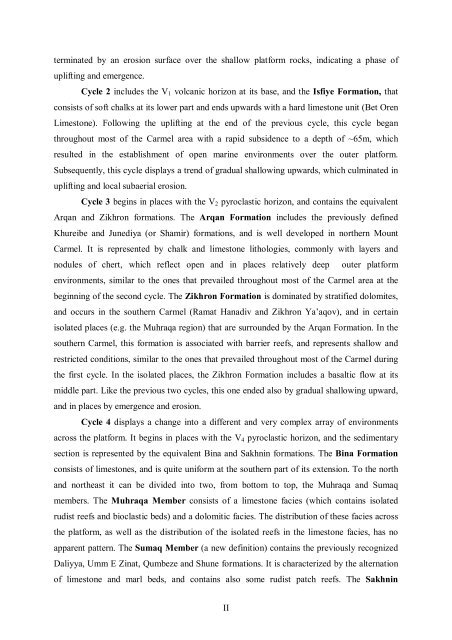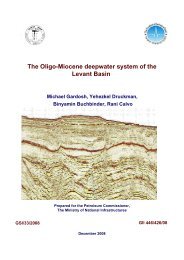terminated by an erosion surface over the shallow platform rocks, indicating a phase <strong>of</strong>uplifting and emergence.Cycle 2 includes the V 1 volcanic horizon at its base, and the Isfiye Formation, thatconsists <strong>of</strong> s<strong>of</strong>t chalks at its lower part and ends upwards with a hard limestone unit (Bet OrenLimestone). Following the uplifting at the end <strong>of</strong> the previous cycle, this cycle beganthroughout most <strong>of</strong> the Carmel area with a rapid subsidence to a depth <strong>of</strong> ~65m, whichresulted in the establishment <strong>of</strong> open marine environments over the outer platform.Subsequently, this cycle displays a trend <strong>of</strong> gradual shallowing upwards, which culminated inuplifting and local subaerial erosion.Cycle 3 begins in places with the V 2 pyroclastic horizon, and contains the equivalentArqan and Zikhron formations. The Arqan Formation includes the previously definedKhureibe and Junediya (or Shamir) formations, and is well developed in northern MountCarmel. It is represented by chalk and limestone lithologies, commonly with layers andnodules <strong>of</strong> chert, which reflect open and in places relatively deep outer platformenvironments, similar to the ones that prevailed throughout most <strong>of</strong> the Carmel area at thebeginning <strong>of</strong> the second cycle. The Zikhron Formation is dominated by stratified dolomites,and occurs in the southern Carmel (Ramat Hanadiv and Zikhron Ya’aqov), and in certainisolated places (e.g. the Muhraqa region) that are surrounded by the Arqan Formation. In thesouthern Carmel, this formation is associated with barrier reefs, and represents shallow andrestricted conditions, similar to the ones that prevailed throughout most <strong>of</strong> the Carmel duringthe first cycle. In the isolated places, the Zikhron Formation includes a basaltic flow at itsmiddle part. Like the previous two cycles, this one ended also by gradual shallowing upward,and in places by emergence and erosion.Cycle 4 displays a change into a different and very complex array <strong>of</strong> environmentsacross the platform. It begins in places with the V 4 pyroclastic horizon, and the sedimentarysection is represented by the equivalent Bina and Sakhnin formations. The Bina Formationconsists <strong>of</strong> limestones, and is quite uniform at the southern part <strong>of</strong> its extension. To the northand northeast it can be divided into two, from bottom to top, the Muhraqa and Sumaqmembers. The Muhraqa Member consists <strong>of</strong> a limestone facies (which contains isolatedrudist reefs and bioclastic beds) and a dolomitic facies. The distribution <strong>of</strong> these facies acrossthe platform, as well as the distribution <strong>of</strong> the isolated reefs in the limestone facies, has noapparent pattern. The Sumaq Member (a new definition) contains the previously recognizedDaliyya, Umm E Zinat, Qumbeze and Shune formations. It is characterized by the alternation<strong>of</strong> limestone and marl beds, and contains also some rudist patch reefs. The SakhninII
Formation consists <strong>of</strong> bedded dolomites, and in southern Carmel it displays a facies changeinto the undivided Bina Formation. The described stratigraphic relationship between the tw<strong>of</strong>ormations is different from the common one in northern <strong>Israel</strong> (where the Bina Formationoverlies the Sakhnin Formation). It is consistent, however, with the observations concerningthe occurrences <strong>of</strong> limestone facies in the Sakhnin Formation, and dolomitic facies in the BinaFormation. The fourth cycle, like the two preceding ones, started with rapid subsidencethroughout most <strong>of</strong> the Carmel. It was different, however, by the establishment <strong>of</strong> reef (andbioclastic products) environments, rather than the planktonic environments that characterizedthe beginnings <strong>of</strong> the previous cycles.The great variety <strong>of</strong> features that is displayed in the different cycles can be related to anumber <strong>of</strong> controlling factors and their mutual interactions.1. Bathymetry. The carbonate platform in the Carmel area was rather flat and uniform duringdeposition <strong>of</strong> the first cycle (Albian). During the Cenomanian-Turonian two subenvironmentswere recognized, the one restricted and relatively shallow, the other openand deeper (65-80 m). Local slopes were established between the two sub-environments,but otherwise there is no evidence <strong>of</strong> a directional and uniform slope. The edge <strong>of</strong> theplatform, whether rimmed or non-rimmed, was well defined, and beyond it started thesteep slope towards the Tethys Ocean.2. Rudist reefs. Rudist reefs occurred as either barrier or isolated forms. The barrier reefswere located along the edge <strong>of</strong> the platform exclusively, even though at certain times somestretches <strong>of</strong> the platform’s edge were not colonized by reefs. One effect <strong>of</strong> the barrier reefswas the restriction <strong>of</strong> water exchange between the open sea and the platform, whichresulted in elevated salinity. The abundant dolomites in association with the barrier reefsare ascribed to these effects. The non-rimmed parts <strong>of</strong> the platform contain mostly chalksand limestones, which reflect normal salinity and improved water circulation. Isolatedreefs are recognized both on the platform and the platform’s edge. They had a key roleduring accumulation <strong>of</strong> the Muhraqa Member (Bina Formation), in affecting bathymetry,sediment type, and water circulation in their proximity.3. Volcanic activity. The majority <strong>of</strong> volcanic eruptions in Mount Carmel were explosive,with only a few effusive ones. It took place in four separate phases from the Latest Albian(99 Myr) to the Late Cenomanian (95.4 Myr), and a single Senonian event (82 Myr). Three<strong>of</strong> these phases (V 1 , V 2 , V 4 ) were active at the beginnings <strong>of</strong> cycles 2, 3, and 4respectively, and one (V 3 ) in the middle <strong>of</strong> the Zikhron Formation (third cycle). Thepyroclastic volcanoes formed relatively small cones, which protruded out <strong>of</strong> the sea duringIII
- Seite 2 und 3: משרד התשתיות הלאומ
- Seite 4 und 5: תקצירהעבודה הנוכחי
- Seite 6 und 7: האחרים, והכתיבה א
- Seite 10 und 11: their activity. Upon cessation of v
- Seite 12 und 13: תוכן הענייניםעמוד14
- Seite 14 und 15: מבואהגוש הטקטוני ה
- Seite 16 und 17: איור 2.מפת העתקים חש
- Seite 18 und 19: איור 3. חתך רוחב גיא
- Seite 20 und 21: שינויי ליתופאצייס
- Seite 22 und 23: איור 5.יחידות הסלע ה
- Seite 24 und 25: ובהתמתנות הנטיות ה
- Seite 26 und 27: לוח 1: תצורת יגורנחל
- Seite 28 und 29: לוח 2: תצורת יגור,
- Seite 30 und 31: ה(ודולומיט, במקו
- Seite 32 und 33: איור 7. יחידות הסלע
- Seite 34 und 35: לוח 3: תופעות הקשורו
- Seite 36 und 37: לוח 4: תצורת עספיא ב
- Seite 38 und 39: לוח 5: סביבות זיכרון
- Seite 40 und 41: נ(משניות שנוצרו ל
- Seite 42 und 43: לוח 6: המדרון המערבי
- Seite 44 und 45: לוח 7:טירת הכרמל.ה
- Seite 46 und 47: לוח 8: סביבת טירת הכ
- Seite 48 und 49: לוח 9: מחזור 3: התצור
- Seite 50 und 51: לוח 10: צפון מערב עמק
- Seite 52 und 53: מחזור ערקן-זיכרון -
- Seite 54 und 55: כ(ר(העליון התקיי
- Seite 56 und 57: איור 9.a. סביבות השקע
- Seite 58 und 59:
לוח 11: תצורת בינה.1מ
- Seite 60 und 61:
לוח 12: תצורת בינה1. פ
- Seite 62 und 63:
איור 11. יחידות הסלע
- Seite 64 und 65:
סביבות מוגנות בסמו
- Seite 66 und 67:
ב.סלעי דולומיט מס
- Seite 68 und 69:
3.5.2. מחזורים סדימנט
- Seite 70 und 71:
3.5.2.2. מחזוריות סדימ
- Seite 72 und 73:
נ(4. יחידות וסלעים
- Seite 74 und 75:
ב(ג(- בלבדסלעי הל
- Seite 76 und 77:
5. מבנה.5.1גיליון עתל
- Seite 78 und 79:
17. איורמפה סטרוקטור
- Seite 80 und 81:
5.2. היחס בין מבנה הכ
- Seite 82 und 83:
איור 19. חתך מורפולו
- Seite 84 und 85:
Achmon, M. and Ben-Avraham, Z., 199
- Seite 86 und 87:
Garfunkel, Z. and Derin, B., 1984.
- Seite 88 und 89:
Ron, H., Freund, R., Garfunkel, Z.
- Seite 90:
Weissbrod, T., 1969. The Paleozoic
















